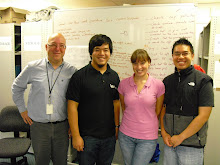Ben O’Brien, a PhD student in the Biomimetics lab, taught Kit and I how to make a DEMES today. DEMES stands for Dielectric Elastomer Minimum Energy Structure. So far, I have made planer DE’s but a DEMES is more 3d.
With Ben we cut some already existing templates on the lasercutter. I imagine that making a drawing on ‘Solidworks’ for a DEMES frame is very complicated. The slightest design change will affect the performance. It took Ben ages to get the right shape for the motion he wanted. The DEMES is miniature which is perfect for what Ben needs to make. For artwork, the design is very small. Scale is important to me as I want the artwork to be accessible to many people. Rather than a group of people peering at a small sculpture in an exhibition space, I would prefer the artwork to be easily visible from a distance if possible. It will be a challenge to increase the scale of the DEMES to an appropriate size. For now, I will stick to what we know works!
Ben showed us all the steps to making the DEMES. Then we got it working. It is very cool. The flexible frame allows the membrane to straighten up and relax. It looks like it is flapping back and forth.
Then it was my turn. What a drama! With some frames already made and ready, it was my job to stretch the VHB. I thought stretching it on one plane was difficult. With a DEMES, in order to curl the membrane over the frame, you have to stretch in with different tensions in different directions. Super tricky. This requires a new stretcher. I found it close to impossible. The VHB kept tearing. It wants to pull away from the paddles so quickly. You have to keep your eyes and fingers on it or it breaks. I broke 3 before I managed to stick one to the strat successfully. One small victory. There is only one thing to do: practise practise practise.
Hei konei ra.
-KatyPie
With Ben we cut some already existing templates on the lasercutter. I imagine that making a drawing on ‘Solidworks’ for a DEMES frame is very complicated. The slightest design change will affect the performance. It took Ben ages to get the right shape for the motion he wanted. The DEMES is miniature which is perfect for what Ben needs to make. For artwork, the design is very small. Scale is important to me as I want the artwork to be accessible to many people. Rather than a group of people peering at a small sculpture in an exhibition space, I would prefer the artwork to be easily visible from a distance if possible. It will be a challenge to increase the scale of the DEMES to an appropriate size. For now, I will stick to what we know works!
Ben showed us all the steps to making the DEMES. Then we got it working. It is very cool. The flexible frame allows the membrane to straighten up and relax. It looks like it is flapping back and forth.
Then it was my turn. What a drama! With some frames already made and ready, it was my job to stretch the VHB. I thought stretching it on one plane was difficult. With a DEMES, in order to curl the membrane over the frame, you have to stretch in with different tensions in different directions. Super tricky. This requires a new stretcher. I found it close to impossible. The VHB kept tearing. It wants to pull away from the paddles so quickly. You have to keep your eyes and fingers on it or it breaks. I broke 3 before I managed to stick one to the strat successfully. One small victory. There is only one thing to do: practise practise practise.
Hei konei ra.
-KatyPie

Above: Cutting VHB meterial to construct our first DEMES
Above: Our first DEMES in action ( with a little help from Ben)
Above: Increasing the applied voltage increases the amount of bending motion on the DEMES
Above: Increasing the frequency increases the speed of the DEMES



No comments:
Post a Comment